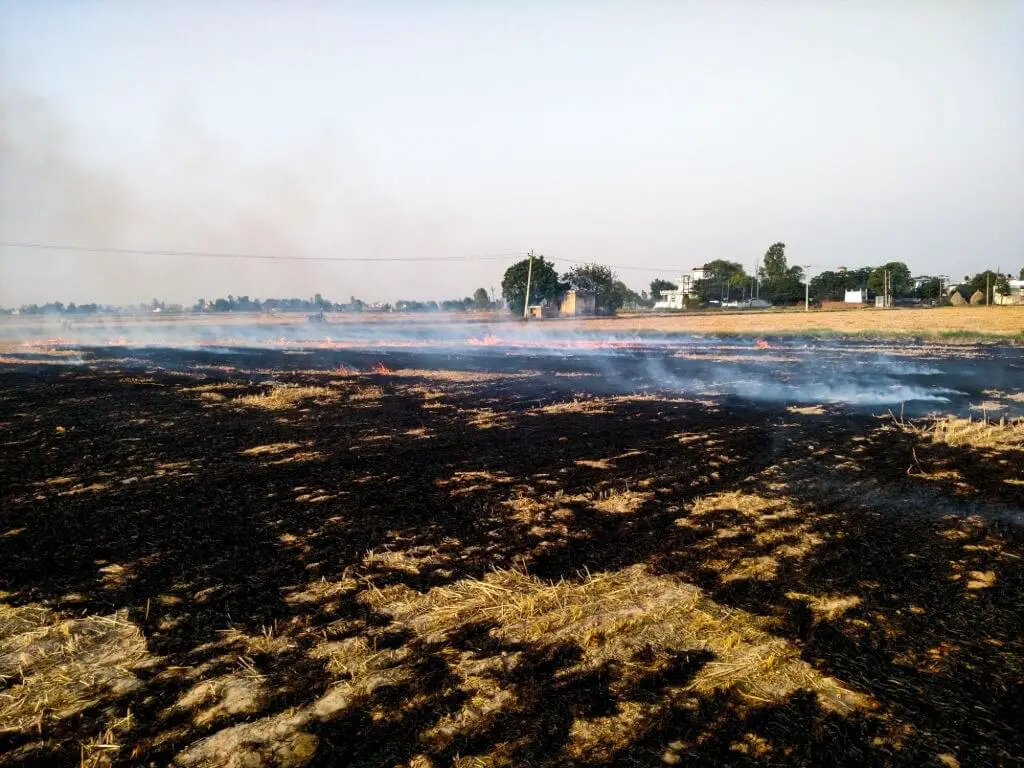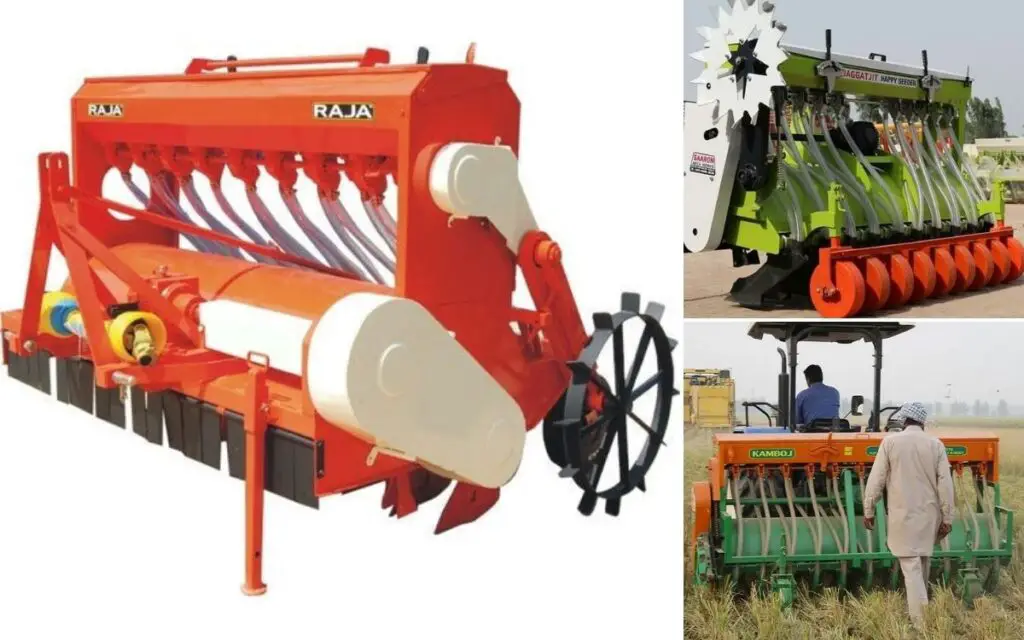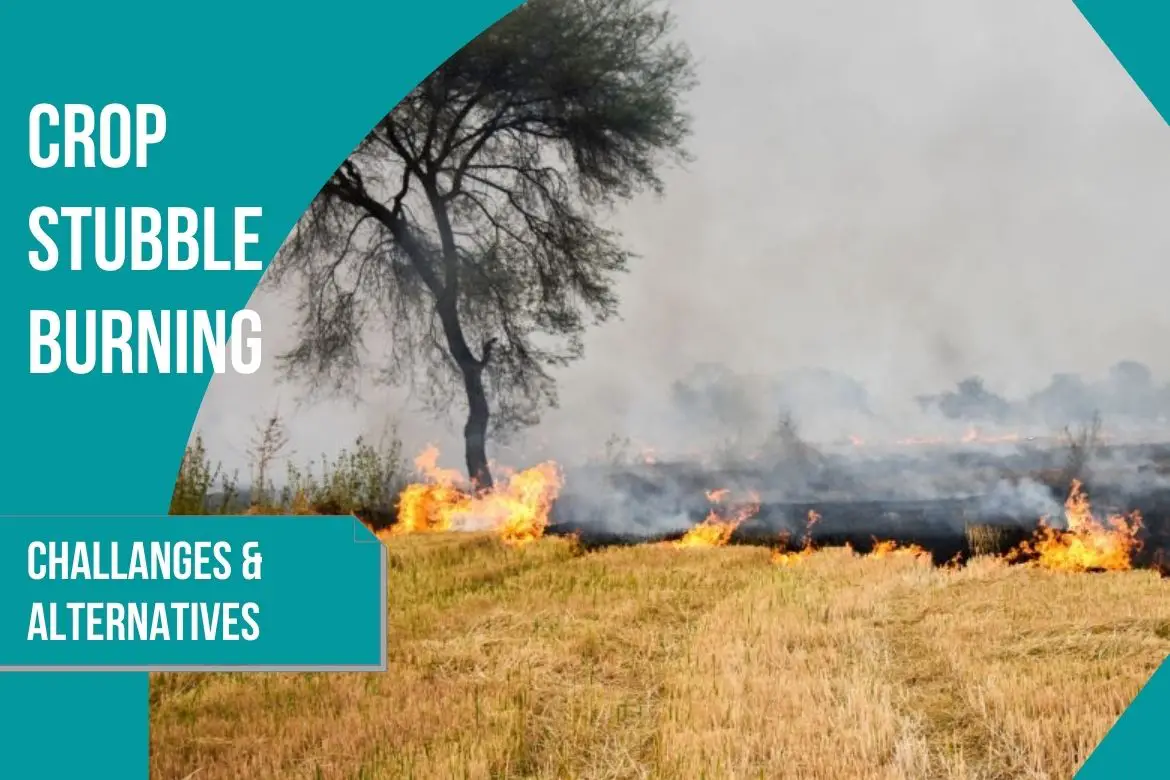Table of Contents
Introduction
Among the major cropping systems in India are rice-wheat. Rice straw management is one of the major concerns of this cropping system. Each year, millions of tonnes of straw are produced from rice and wheat cultivation. Straw from wheat is used to feed cattle. However, rice straw remains a major problem for farmers.
Approximately 220 lakh tonnes (22 million tonnes) of straw are generated only from paddy fields in Punjab alone every year, and 90 percent of that is burned in the fields, according to PAU report provided by the Department of Soil Science.
There is a very short time span between harvesting of rice and sowing of wheat in rice-wheat cropping system. This unfortunately leads to farmers opting for rice crop stubble burning to quickly prepare the field for wheat sowing.
For farmers, stubble burning practice is the easiest way to manage rice residue. However, stubble burning has enormous environment degrading consequences.
What is Stubble Burning?

Stubble burning involves setting fire to crop residue to remove it from the field for sowing the next crop. The method is used in areas where the ‘combine harvesting method’ is used.
A combine harvester is a machine that harvests, threshes (meaning separates the grain), and also cleans the grains.

However while using this machine, the machine does not cut close enough to the ground, leaving behind stubble that is useless to farmers.
It is important for farmers to plant the next crop in time for it to yield a full yield and also maximum profit. Hence, burning the stubble is the fastest and cheapest way to clear the field according to the farmers.
Why stubble burning is done ?
Although farmers are discouraged by the government from burning stubble, they still prefer it because it is cheap and less time consuming.
Due to a lack of financial and technological resources, it is not feasible for farmers to consider alternatives to stubble burning, such as plowing it or investing it for other purposes.
- Two successive crops are planted within a short period of time
The uprooting, cutting, burying, and watering of the stubble takes almost two days. Once the stubble is turned, it takes almost 45 days for it to turn into manure.
Planting the next crop at the right time (mostly November-end) is critical.
Furthermore, this process costs farmers Rs 500-700 per acre per day while setting fire to the stubble hardly costs them anything.
- Insufficient knowledge of stubble management
Despite the fact that farmers are unaware of residue management in short period, and they consider burning is the easiest method to get rid of crop remains, government of India is making effort to reach out and educate them
- Use of Mechanical harvesters
Rice being most important cereal crop and produced in large areas, usage of man power for harvesting is extravagant. Consequently, mechanical harvesters came into existence in which combine harvester is prominently used. This leaves significant amount of straw in the field itself since it is not designed to cut the plant to surface and incorporate in to soil
- Absence of responsibility
Despite having knowledge on residue management and its impact on environment, few people desperately burn stubbles in the field due to which new rules/laws has set up by lawmakers to control these irresponsible acts by few farmers
- Crop residues are not suitable for cattle
In dairy farms, the majority of cereal and forage crop residue is used as cattle feed. However, rice straw is not preferred as cattle feed in northern regions due to its high silica, ligno-cellulose, and limited protein content (2-7%), which prevents it from being taken to the dairy. Despite this, basmati rice feed is sometimes preferred by cattle due to its high palatability.
Disadvantages of stubble burning
1 . Environment pollution
Among the potential greenhouse gases produced by burning crop residues are methane, carbon monoxide, nitrous oxide, and other hydrocarbons, which are chemically and radioactively dangerous. This causes damage to the ozone and environmental pollution.
Stubble burning releases which gases ?
It is estimated that rice straw burning releases carbon (C) as CO2 (70%), CO (7%) and CH4 (0.66%) while nitrogen (N) is released as N2O (2.09%).
Furthermore, burning agriculture waste also emits a great deal of particulate matter, which contains a large number of organic and inorganic organisms.
2 . Human health is at risk
Biomass smoke contains a variety of known or suspected carcinogens that can cause lung diseases when they are inhaled in large quantities.
Pollutants, after being released into the atmosphere, disperse in the surrounding areas, undergo physical and chemical transformations, and eventually adversely affect human health.
Human well being is directly impacted by stubble burning. The reason for this is that all the toxic gases and heavy metals released by residue burning act as slow poisons in the human body.
Studies have found that air pollution increases the risk of health problems in pregnant women, infants, the elderly, and people with a history of illnesses.
The exposure of humans to these potentially hazardous gases has been associated with a wide range of respiratory, cardiovascular, neurological, skin and optical diseases.
Carbon dioxide emitted creates eye irritation and the oxides of Sulphur dioxide and Nitrogen directly affect lungs, skin, blood and respiratory functions which can trigger serious diseases such as cancer
3 . Nutrients and microbes are lost in the soil
The loss of soil nutrients occurs as a result of straw burning. In general, burning of one ton of rice straw will result in losses of 400 kilograms of organic carbon, 5.5 kilograms of nitrogen, 2.3 kilograms of phosphorus, 25 kilograms of potash, and 1.2 kilograms of sulfur.
In addition, the heat generated by paddy straw burning kills useful microbes in the soil. Thus, burning straw negatively affects soil fertility and health.
crop stubble blazing increases the soil temperature by up to 33.8–42.2 °C
periodic burning will reduce the beneficial soil bacterial population by up to 50%. It also decreases total nitrogen, carbon, and available nitrogen in the top 0–15 cm soil layer, along with soil organic matter reduction.
4 . Road accidents and transportation problems
Burning of stubble in Punjab, Rajasthan and Haryana causes a thick blanket of smog that poses not only a serious health risk to the population of Delhi and surrounding areas during winter but also visibility problems.
Transport problems are caused by the smoke screen that results after burning. Every day, numerous accidents result in the loss of valuable lives and wealth.
5 . The loss of biodiversity
The burning of straw destroys trees and plants around fields and along roadsides, thus destroying biodiversity.
Stubble burning alternatives
1 . In-situ management of paddy straw
It is easy to manage stubbles by incorporating them into the field. Farmers, however, do not prefer in-situ incorporation since the stubble takes time to decompose.
There are various ways this may adversely affect wheat productivity, including late wheat sowing and nitrogen immobilization, which results in inadequate nitrogen supply.
in-situ incorporation is the best alternative available to burning of rice residue.
A study conducted by the authors concluded that incorporating rice residue in the soil 10, 20 or 40 days before sowing the wheat crop does not adversely affect the following crops.
Furthermore, several machines have been developed that are used to manage paddy straw in situ. Contact Punjab agricultural university (PAU) for more details.
2 . Using Happy seeder

In combine harvested paddy fields, the Happy seeder is used to sow wheat without removing the straw.
It is critical to spread the loose straw uniformly in the field for the happy seeder to work properly. The paddy should be harvested using a combine harvester equipped with the PAU super straw management system (SMS).
Advantages of happy seeder
- Rice stubble must no longer be burned before planting wheat with the Happy Seeder, reducing air pollution.
- Prevents erosion from wind and water.
- Increases water intake
- Ensures that organic matter does not degrade.
- As a result of direct sowing, soil disturbance is reduced, allowing it to retain more nutrients and organic matter.
- In addition to saving money, the Happy Seeder reduces fuel and labor costs because less time is spent on field operations.
Disadvantages and challenges of happy seeder
- Nitrogen is temporarily trapped in paddy fields by the remaining stubble. As a result, wheat’s protein content may be lower.
- Lack of knowledge, motivation, finance and reluctance in adoption of Happy Seeder.
- Cost, risk aversion, and subsidies for using herbicides and electricity are among other reasons why this method is not adopted.
- Happy Seeders will be subsidized to overcome these barriers.
3 . Mulcher / Straw Chopper
Paddy Straw Chopper-cum-Spreader is a machine developed by the PAU for chopping and spreading rice straw and stubble in the field. Rotating tillers can be used to mix the chopped straw into the soil after applying a light irrigation.

Advantages of Mulcher / Straw Chopper
- Prevents wind erosion and water.
- Increases the intake of water.
- Prevents organic matter from deteriorating.
- This machine can chop all types of crop residue including wheat, paddy, maize, sunflower, sorghum, etc. Therefore, this makes it ideal for customers working under contract as it offers high versatility.
- In one operation, the machine chops the left stubbles and spreads them on the ground.
- Once the stubbles are chopped and spread, they are easily buried in the soil using a rotavator or disc harrow and decay at the end of irrigation.
Disadvantages and challenges of Mulcher / Straw Chopper
- This is an expensive option for small or marginal farmers.
- Controlling seed depth and seeding a following crop are problematic.
- Holds nitrogen in place temporarily. Hence, wheat may have a lower protein content.
- During wet seasons, weeds, including cheat grass and volunteer wheat, are difficult to control.
- In comparison to plowed land, soil stays warmer in the fall and colder in the spring seasons.
4 . Biological Decomposition of Straw by bacteria and fungi
Effective decomposition can substitute for straw burning. Straw decomposition requires cellulose and lignin-degrading microorganisms.
By decomposing rice straw, carbon, nitrogen, and other nutrients are recycled back into the soil, restoring soil fertility. Microbial processes may occur both under aerobic and anaerobic conditions. However, aerobic pathways are more critical for most soils than anaerobic ones.
For example, the white rot fungus (Pleurotus sp.) can decompose other agricultural wastes besides rice straw, such as coir pith, banana sheaths (dried), sugarcane trash, millets, and pulses. Eous, platypus, djamor and sajorcaju are some of the most widely used white rot fungi.
Management of crop residue
1 . Crop residue as animal feed
Feeding animals with rice residues is an option. In Punjab, however, this practice is not very popular due to the high silica content of rice residue. In this state, almost 40 percent of the wheat straw produced is used as dry fodder for livestock.
Punjab State Council for Science & Technology PSCST took up a pilot project at Punjab Agricultural University, Ludhiana, to encourage the use of rice residue as fodder.
Several trials were conducted at PAU on natural fermentation of paddy straw for use as a livestock feed enriched with protein. Animals fed this feed showed improved health and milk production.
2 . Utilization of crop residues in biothermal power plants
Electricity can also be generated from rice residue. Biomass is the fuel used in the thermoelectric plant at Jalkheri in Fatehgarh Sahib. It is the country’s first plant to use renewable energy sources.
For the generation of electricity, this plant can utilize rice husk, wood chips, straw from various plants, such as paddy, wheat, etc.
In addition to providing additional income to thousands of farmers, the project reduces the emission of smoke and other pollutants caused by the burning of agricultural waste.
3 . Cattle bedding made from rice residue
Research conducted by the Department of Livestock Production and Management of the College of Veterinary Sciences of Punjab Agricultural University (now Guru Angad Dev Veterinary And Animal Sciences University) found that paddy straw can be used as bedding material during winter by farmers.
This bedding increases the quality and quantity of milk by providing comfort to the animals, udder health, and leg health.
This method helps the animals maintain a reasonable rate of body heat loss as well as keep themselves warm.
In addition, it provides a dry, comfortable, hygienic environment that is non-slippery, that also prevents injuries. Furthermore, a kilogram of straw absorbs approximately 2-3 kilograms of urine from an animal shed
Using paddy straw as bedding also contributed to an improvement in net profit per animal per month from the sale of an additional amount of milk.
This technology has been demonstrated to farmers by the PAU through training courses, radio/TV talks, and leaflets.
4 . Rice residue for paper production
Rice straw is also an ideal raw material for making paper and pulp boards. Paper is also produced from paddy straw combined with wheat straw. Paper mills are already using this technology to meet 60 percent of their energy needs.
5 . Rice residue as growing medium in mushroom farming
Paddy straw can also be used as growing medium for mushroom cultivation, including Agaricus bisporus, Volvariella volvacea, and Pleurotus spp. The yield of these mushrooms is 300, 120–150, and 600 g per kilogram of paddy straw, respectively.
Mushrooms grown on paddy straw are called paddy straw mushrooms (Volvariella volvacea).
A variety of agricultural wastes can also be used to prepare the substrate for growing this mushroom, such as dried banana leaves, water hyacinth, oil palm bunch waste, cotton and wood waste.
6 . Making compost from crop residues
Composting is a traditional method of preparing organic matter enriched with beneficial nutrients.
The process of composting is a natural breakdown of organic materials involving microorganisms such as bacteria that break down animal waste, crop residues, vegetable waste, and some municipal waste.
When decomposition is complete, it can be used as natural organic fertilizer. In addition to its physical, chemical, and biological properties, this natural fertilizer increases soil fertility.
Paddy straw produces almost 3.2 tonnes of nutrient-rich FYM per hectare. Farmers can prepare this residue in their sheds and use it as organic fertiliser to increase crop yields by 4-9 percent.
7 . Biogas production using crop residue
Agricultural wastes can be converted into biogas for use as an alternative energy source. The main source of lignocellulose for biogas production is crop residues, such as rice straw.
8 . Crop residue used for mulching
Using rice straw as a mulch in the field has so many benefits. Mulching maintains soil moisture, controls weeds, and stabilizes soil temperature, which promotes healthy plant growth.
9 . Paddy straw geyser
A model of a paddy straw geyser has been developed by the Punjab university that uses straw bales as fuel for water heating in order to properly utilise rice residue.
Government Initiatives to Control stubble burning
In November 2015, the National Green Tribunal ordered Delhi and its neighboring states to cease the practice of stubble burning. However, the order had little effect.
The Centre approved a scheme worth Rs 1,151 crore aimed at promoting in-situ crop residue management through the provision of subsidized THS machines. Upon approval of their applications, users are required to deposit the subsidised price amount with the agriculture department.
Paddy stubble power plants are planned in 30 areas of Punjab, mostly paddy-growing areas. 44 lakh tonnes of paddy stubble will be used in these plants. There are currently seven plants in operation with a total capacity of 62.5 megawatts.
Small and marginal farmers in Punjab were offered a ‘stubble-burry’ scheme to curb stubble burning with the help of the Agriculture Department. According to the plan, paddy stubble can be removed from the main field and buried in a pit either on their own farmland or in the wastelands.
Under the Mahatma Gandhi National Rural Employment Guarantee Act (MGNREGA), the District Administration is responsible for providing workers to farmers to dig up the compost pits.

